Vegetation Dynamics in a Loess Grassland: Plant Traits Indicate Stability Based on Species Presence, but Directional Change When Cover Is Considered
Abstract
1. Introduction
2. Results
3. Discussion
4. Materials and Methods
Author Contributions
Funding
Institutional Review Board Statement
Informed Consent Statement
Data Availability Statement
Acknowledgments
Conflicts of Interest
Abbreviations
| RLF | Raunkiaer’s life forms |
| Th | therophyte |
| TH | hemitherophyte |
| H | hemicryptophyte |
| G | geophyte |
| Ch | chamaephyte |
| N | nanophanerophyte |
| M | microphanerophyte |
| FLE | floristic element (chorological type) |
| SW | seed weight category |
| na | not available |
Appendix A
| Plots | Plot-1 | Plot-2 | Plot-3 | Plot-4 | RLF | FLE | SW | ||||||||
|---|---|---|---|---|---|---|---|---|---|---|---|---|---|---|---|
| Years | 2018 | 2019 | 2020 | 2018 | 2019 | 2020 | 2018 | 2019 | 2020 | 2018 | 2019 | 2020 | |||
| Species Name | |||||||||||||||
| Achillea collina J. Becker | 2.0 | 0.1 | 1.0 | 1.0 | H | CON | 1 | ||||||||
| A. pannonica Scheele | 2.0 | 1.0 | 0.1 | 0.5 | 1.0 | 0.1 | 2.0 | 5.0 | 1.0 | 3.0 | 1.0 | 0.5 | H | PON | 1 |
| Adonis vernalis L. | 2.0 | 1.0 | 2.0 | 4.0 | 1.0 | 3.0 | 4.0 | 3.0 | 4.0 | 3.0 | 2.0 | 2.0 | H | CON | 7 |
| Agrimonia eupatoria L. | 0.1 | 1.0 | 1.0 | 2.0 | 2.0 | 3.0 | 3.0 | H | EUR | 7 | |||||
| Agropyron intermedium Host | 0.1 | 9.0 | 0.1 | 10.0 | 2.0 | 15.0 | 14.0 | G | PoM | 6 | |||||
| A. repens (L.) P. B. | 0.1 | 1.0 | 5.0 | 0.1 | 3.0 | 10.0 | G | CIR | 5 | ||||||
| Ailanthus altissima (Mill.) Swingle | 0.1 | MM | ADV | 7 | |||||||||||
| Ajuga reptans L. | 0.1 | H-Ch | EUR | 4 | |||||||||||
| Anthericum ramosum L. | 1.0 | G | CEU | 6 | |||||||||||
| Arabis hirsuta (L.) Scop. | 0.1 | 0.1 | 0.1 | 0.1 | 0.5 | 0.1 | TH-H | CIR | 1 | ||||||
| Arrhenatherum elatius (L.) J. et C. Presl | 0.1 | 1.0 | 0.1 | 0.5 | H | EUA | 5 | ||||||||
| Asperula cynanchica L. | 0.1 | 0.5 | 1.0 | 1.0 | H | PoM | 3 | ||||||||
| Astragalus austriacus Jacq. | 1.0 | 0.5 | 0.5 | H | CON | 3 | |||||||||
| A. onobrychis L. | 1.0 | 1.0 | 0.1 | 1.0 | 0.5 | 0.5 | H | CON | 4 | ||||||
| Betonica officinalis L. | 0.1 | 0.5 | 0.1 | H | EUA | 4 | |||||||||
| Bothriochloa ischaemum (L.) Keng | 0.5 | 0.5 | 0.1 | 0.1 | 1.0 | H | PoM | 2 | |||||||
| Brachypodium pinnatum (L.) P. B. | 19.0 | 30.0 | 30.0 | 40.0 | 45.0 | 30.0 | 9.0 | 20.0 | 25.0 | 25.0 | 25.0 | 13.0 | H(Ch) | EUA | 6 |
| Brassica elongata Ehrh. | 0.1 | TH-H | CON | 2 | |||||||||||
| Briza media L. | 2.0 | 2.0 | 0.5 | 0.1 | 3.0 | 0.1 | 1.0 | H | KOZ | 3 | |||||
| Bromus erectus Huds. | 0.1 | 0.1 | H | PaB | 6 | ||||||||||
| B. inermis Leyss. | 0.1 | 5.0 | 1.0 | 8.0 | H | CIR | 5 | ||||||||
| Campanula bononiensis L. | 0.1 | 0.1 | 2.0 | 0.5 | 0.1 | H | EUA | 1 | |||||||
| C. glomerata L. | 2.0 | 0.1 | 0.1 | H | EUA | 1 | |||||||||
| Carduus acanthoides L. | 0.1 | TH | EUR | 4 | |||||||||||
| Carex humilis Leyss. | 5.0 | 3.0 | 2.0 | 0.1 | 0.1 | 0.1 | 0.5 | 1.0 | 0.5 | H | CON | 4 | |||
| C. michelii Host | 1.0 | 1.0 | 0.5 | 2.0 | 5.0 | 3.0 | 38.0 | 15.0 | 13.0 | 0.1 | 0.1 | 1.0 | H | SMO | 5 |
| C. tomentosa L. | 0.1 | 0.1 | 0.1 | 0.1 | 0.1 | 0.1 | 0.1 | 0.1 | 0.1 | G | EUA | 4 | |||
| Carlina vulgaris L. | 0.1 | 0.5 | 0.1 | 0.1 | TH-H | EUA | 4 | ||||||||
| Centaurea micranthos S.G. Gmel. | 0.1 | 0.1 | TH-H | PON | 4 | ||||||||||
| C. pannonica (Heuff.) Simk. | 1.0 | 0.5 | 1.0 | 2.0 | 4.0 | 4.0 | 0.5 | 1.0 | 2.0 | 3.0 | 2.0 | 5.0 | H | PoP | 4 |
| C. sadlerana Janka | 3.0 | 5.0 | 7.0 | H | PAN | 6 | |||||||||
| Chamaecytisus austriacus (L.) Link | 10.0 | 10.0 | 13.0 | 8.0 | 6.0 | 5.0 | 2.0 | 5.0 | 3.0 | 0.1 | 0.1 | 0.5 | N | PoP | 6 |
| Chrysanthemum leucanthemum L. | 0.1 | 0.1 | H | EUA | 2 | ||||||||||
| Cirsium arvense (L.) Scop. | 1.0 | 2.0 | 0.1 | G | EUA | 4 | |||||||||
| Clinopodium vulgare L. | 9.0 | 3.0 | 1.0 | H | CIR | 2 | |||||||||
| Cornus sanguinea L. | 0.1 | 0.1 | 0.1 | 0.1 | 0.1 | 0.1 | 0.1 | 0.1 | M | SME | 8 | ||||
| Coronilla varia L. | 0.1 | 0.1 | H | PoM | 5 | ||||||||||
| Crataegus monogyna Jacq. | 0.1 | 1.0 | 0.5 | 2.0 | 2.0 | 3.0 | 2.0 | 2.0 | 3.0 | 1.0 | 1.0 | 3.0 | M | EUR | 7 |
| Dactylis glomerata L. | 1.0 | 2.0 | 0.5 | 2.0 | 1.0 | 0.1 | 0.1 | 8.0 | 2.0 | 0.5 | H | KOZ | 3 | ||
| Daucus carota L. | 0.1 | 0.1 | 0.5 | 1.0 | 0.1 | Th-TH | KOZ | 5 | |||||||
| Dianthus pontederae Kern. | 0.1 | 0.5 | 0.1 | 0.1 | 0.5 | 0.1 | 0.1 | 0.1 | 0.1 | 0.1 | 0.1 | H | PAN | 3 | |
| Dorycnium germanicum (Gremli) Rikli | 3.0 | 1.0 | 2.0 | Ch | ALB | 5 | |||||||||
| Eryngium campestre L. | 2.0 | 0.5 | 1.0 | 4.0 | 3.0 | 3.0 | 1.0 | 2.0 | 2.0 | 1.0 | 1.0 | 1.0 | H | PoM | 5 |
| Euphorbia pannonica Host | 10.0 | 14.0 | 15.0 | 8.0 | 4.0 | 7.0 | 15.0 | 20.0 | 14.0 | 6.0 | 5.0 | 5.0 | H | PaB | 4 |
| Falcaria vulgaris Bernh. | 1.0 | 0.5 | 0.1 | 1.0 | 0.1 | 0.1 | Th-TH | EUA | 4 | ||||||
| Festuca rupicola Heuff. | 25.0 | 35.0 | 25.0 | 20.0 | 25.0 | 25.0 | 10.0 | 20.0 | 25.0 | 20.0 | 30.0 | 35.0 | H | EUA | 3 |
| Filipendula vulgaris Mönch | 15.0 | 10.0 | 8.0 | 8.0 | 11.0 | 5.0 | 15.0 | 12.0 | 12.0 | 15.0 | 12.0 | 10.0 | H | EUA | 3 |
| Fragaria viridis Duch. | 0.1 | 0.5 | 0.1 | 1.0 | 1.0 | 0.5 | 2.0 | 3.0 | 2.0 | 3.0 | 3.0 | 3.0 | H | CON | 2 |
| Galium aparine L. | 0.1 | Th | KOZ | 6 | |||||||||||
| G. glaucum L. | 1.0 | 1.0 | 0.1 | 1.0 | 1.0 | 1.0 | 0.1 | 0.1 | 0.1 | 0.1 | 0.5 | 1.0 | H | PoM | 4 |
| G. verum L. | 7.0 | 8.0 | 5.0 | 6.0 | 15.0 | 5.0 | 5.0 | 15.0 | 6.0 | 5.0 | 10.0 | 2.0 | H | EUA | 3 |
| Helictotrichon praeustum (Rchb.) Tzvelev | 1.0 | 1.0 | 0.5 | 0.5 | 2.0 | 6.0 | 5.0 | 10.0 | 3.0 | 2.0 | H | EUR | na | ||
| Helictotrichon pubescens (Huds.) Pilger | 1.0 | 1.0 | 0.1 | 1.0 | 2.0 | 1.0 | 1.0 | 0.1 | 0.5 | 5.0 | 0.1 | 1.0 | H | EUA | 5 |
| Hieracium cymosum L. | 0.1 | 0.5 | 0.1 | 0.1 | H | EUA | na | ||||||||
| H. sabaudum L. | 0.1 | 0.1 | H | CEU | 2 | ||||||||||
| Inula sp. | 0.1 | 0.1 | H | CON | na | ||||||||||
| Knautia arvensis (L.) Coult. | 1.0 | 2.0 | 2.0 | 1.0 | 1.0 | 1.0 | 2.0 | 1.0 | 0.5 | 1.0 | 1.0 | 1.0 | H | EUA | 5 |
| Koeleria cristata (L.) Pers. | 1.0 | 1.0 | 0.1 | 0.1 | 0.1 | H | KOZ | 2 | |||||||
| Lathyrus tuberosus L. | 0.1 | 0.1 | H-G | EUA | 7 | ||||||||||
| Leontodon hispidus L. | 0.1 | 0.1 | 0.1 | 0.1 | H | EUR | 4 | ||||||||
| Ligustrum vulgare L. | 0.1 | M | AsM | 7 | |||||||||||
| Linum catharticum L. | 0.1 | 0.1 | 0.1 | Th(H) | EUR | 1 | |||||||||
| L. flavum L. | 0.1 | 0.5 | 1.0 | 0.1 | 0.5 | H | PoP | 3 | |||||||
| Lotus corniculatus L. | 1.0 | 0.1 | 0.1 | 1.0 | 0.5 | 0.5 | 1.0 | 0.1 | 0.1 | H | EUA | 4 | |||
| Luzula campestris (L.) Lam. et DC. | 0.1 | 0.1 | H | KOZ | 3 | ||||||||||
| Medicago falcata L. | 3.0 | 0.1 | 0.5 | 5.0 | 2.0 | 2.0 | 5.0 | 2.0 | 3.0 | 3.0 | 5.0 | 2.0 | H | EUA | 4 |
| M. lupulina L. | 0.1 | Th-TH | EUA | 4 | |||||||||||
| Melilotus officinalis (L.) Pall. | 0.1 | 0.1 | 0.1 | 0.1 | 0.1 | Th-TH | EUA | 4 | |||||||
| Muscari comosum (L.) Mill. | 0.1 | 0.1 | G | SME | 6 | ||||||||||
| M. racemosum (L.) Mill. | 0.1 | G | SME | 5 | |||||||||||
| Ononis spinosa L. | 1.0 | 1.5 | 1.0 | 0.5 | 0.5 | 0.5 | H-Ch | EUR | 5 | ||||||
| Ornithogalum kochii Parl. | 0.1 | 0.5 | 0.1 | 0.1 | G | PoM | na | ||||||||
| Orobanche teucrii Holandre | 0.1 | 0.1 | G | CEU | 1 | ||||||||||
| Phleum phleoides (L.) Karsten | 0.1 | 0.1 | 0.1 | 0.1 | 0.1 | H | CON | 1 | |||||||
| Picris hieracioides L. | 0.1 | 0.5 | 2.0 | 0.1 | 0.1 | 0.1 | 0.1 | 1.0 | 0.1 | 2.0 | 1.0 | TH-H | EUA | 3 | |
| Pimpinella saxifraga L. | 0.1 | 0.1 | 0.1 | 0.5 | 0.1 | 0.5 | 0.5 | 0.5 | 0.5 | 0.1 | 2.0 | H | EUA | 3 | |
| Plantago media L. | 1.0 | 0.5 | 0.5 | 0.5 | 0.1 | 0.1 | H | EUA | 2 | ||||||
| Poa pratensis L. | 1.0 | 1.0 | 0.1 | 8.0 | 0.5 | 0.5 | 2.0 | 1.0 | 0.1 | 1.0 | H | KOZ | 2 | ||
| Prunella grandiflora (L.) Scholler | 0.1 | 0.1 | 0.5 | 0.1 | 0.1 | H | EUR | 3 | |||||||
| P. laciniata (L.) Nath. | 0.1 | 0.5 | 0.1 | 0.1 | H | SME | 4 | ||||||||
| P. x bicolor Beck | 0.1 | 0.1 | 1.0 | 0.5 | 1.0 | 0.1 | H | SME | na | ||||||
| Prunus cerasifera Ehrh. | 0.1 | 0.1 | 0.1 | M | ADV | 8 | |||||||||
| P. spinosa L. | 0.1 | 0.1 | 0.5 | 0.1 | 0.1 | 0.5 | 0.1 | 0.5 | 0.5 | 4.0 | 8.0 | 13.0 | M | EUR | 8 |
| Ranunculus polyanthemos L. | 1.0 | 0.5 | 0.1 | 0.1 | 0.1 | 0.1 | 2.0 | 1.0 | 0.5 | H | PON | 5 | |||
| Rhamnus catharticus L. | 0.1 | 0.1 | 0.1 | 0.1 | 0.1 | 0.1 | 0.1 | 0.1 | 0.1 | M | EUA | 7 | |||
| Salvia nemorosa L. | 0.1 | 0.5 | 0.5 | H | EUR | 3 | |||||||||
| S. pratensis L. | 3.0 | 8.0 | 7.0 | 4.0 | 5.0 | 3.0 | 5.0 | 10.0 | 6.0 | 4.0 | 7.0 | 6.0 | H | EUR | 4 |
| Sanguisorba minor Scop. | 0.1 | H | EUR | 6 | |||||||||||
| Scabiosa ochroleuca L. | 1.0 | 0.1 | 0.1 | 0.1 | 1.0 | 0.1 | 1.0 | H | CON | 4 | |||||
| Senecio jacobaea L. | 0.1 | 0.1 | 0.1 | 0.1 | H | EUA | 2 | ||||||||
| Seseli annuum L. | 1.0 | 0.1 | 0.1 | 0.1 | 0.1 | 0.1 | 0.5 | 0.1 | 0.1 | 0.1 | 0.1 | 0.5 | Th-TH-H | CON | 2 |
| Setaria viridis (L.) P. B. | 3.0 | 0.1 | Th | EUA | 3 | ||||||||||
| Stachys recta L. | 0.1 | 0.1 | 0.1 | H | PoM | 4 | |||||||||
| Taraxacum officinale Weber | 0.1 | 0.1 | 0.1 | 0.1 | H | EUA | 2 | ||||||||
| T. serotinum (W. et K.) Poir. | 0.5 | 0.5 | 0.5 | 1.0 | 2.0 | 2.0 | H | PoP | 3 | ||||||
| Teucrium chamaedrys L. | 8.0 | 8.0 | 8.0 | 3.0 | 3.0 | 2.0 | 15.0 | 15.0 | 6.0 | 10.0 | 8.0 | 5.0 | Ch | SME | 4 |
| Thesium linophyllon L. | 0.1 | 0.1 | 0.1 | 0.1 | 0.1 | 0.1 | 0.1 | 0.1 | G-H | CEU | 5 | ||||
| Thlaspi perfoliatum L. | 0.1 | 0.1 | Th | SME | 2 | ||||||||||
| Thymus pannonicus All. | 1.0 | 5.0 | 0.1 | 0.1 | 1.0 | 1.0 | 2.0 | 3.0 | 0.5 | Ch | CEU | na | |||
| Tragopogon orientalis L. | 1.0 | 2.0 | 0.1 | 0.1 | 0.5 | 0.1 | TH-H | EUA | 6 | ||||||
| Trifolium alpestre L. | 0.1 | 0.1 | 3.0 | 1.0 | 0.1 | 0.1 | H | CEU | 5 | ||||||
| Trifolium montanum L. | 1.0 | 3.0 | 1.0 | 3.0 | 1.0 | 1.0 | 2.0 | 5.0 | 1.0 | 1.0 | 2.0 | 1.0 | H | CON | 3 |
| Verbascum phoeniceum L. | 0.5 | 1.0 | 0.5 | 0.1 | 1.0 | 0.5 | H | PON | 1 | ||||||
| Veronica austriaca L. | 0.1 | 0.1 | 0.1 | 0.1 | H | PON | 1 | ||||||||
| Veronica spicata L. | 0.5 | 0.1 | 0.1 | 0.1 | 0.1 | 0.1 | 0.5 | 0.5 | 0.1 | H-Ch | EUA | 1 | |||
| Viola canina L. | 0.1 | 0.1 | H | EUA | 3 | ||||||||||
| indet. dicot. 1 | 0.1 | ||||||||||||||
| indet. dicot. 2 | 0.1 | ||||||||||||||
| Number of species | 71 | 62 | 69 | 51 | 39 | 45 | 52 | 44 | 48 | 62 | 53 | 63 | |||
| Total cover (%) | 140.8 | 169.0 | 141.9 | 141.0 | 144.6 | 120.4 | 160.9 | 178.5 | 161.5 | 162.8 | 172.8 | 155.1 | |||
References
- Zólyomi, B. Természetes növénytakaró (Natural vegetation). In Magyarország Nemzeti Atlasza (National Atlas of Hungary); Pécsi, M., Ed.; Kartográfiai Vállalat: Budapest, Hungary, 1989; p. 89. [Google Scholar]
- Penksza, K.; Kiss, T.; Herczeg, E.; Nagy, A.; Malatinszky, Á. Anthropogenic impacts and management of natural grasslands on kurgans. In Kurgan Studies: An Environmental and Archaeological Multiproxy Study of Burial Mounds in the Eurasian Steppe Zone; Pető, Á., Barczi, A., Eds.; BAR International Series: Oxford, UK, 2011; pp. 329–338. [Google Scholar]
- Tóth, A.C.; Deák, B.; Nyilas, I.; Bertalan, L.; Valkó, O.; Novák, T. Iron age burial mounds as refugia for steppe specialist plants and invertebrates—Case study from the Zsolca mounds (NE Hungary). Hacquetia 2019, 18, 189–200. [Google Scholar] [CrossRef]
- Szerényi, J. Adatok az Észak-Mezőföld löszflórájához. Kitaibelia 2000, 5, 249–270. [Google Scholar]
- Molnár, Z.; Biró, M.; Bartha, S.; Fekete, G. Past Trends, Present State and Future Prospects of Hungarian Forest-Steppes. In Eurasian Steppes. Ecological Problems and Livelihoods in a Changing World. Plant and Vegetation; Werger, M.J.A., van Staalduinen, M.A., Eds.; Springer: Dordrecht, The Netherlands, 2012; Volume 6, pp. 209–252. [Google Scholar] [CrossRef]
- Zólyomi, B. Rekonstruált növénytakaró. [Reconstructed vegetation.] 1:1500000. In Magyarország Nemzeti Atlasza; Radó, S., Ed.; Kartográfiai Vállalat: Budapest, Hungary, 1967; pp. 21–31. [Google Scholar]
- Zólyomi, B.; Fekete, G. The Pannonian loess steppe: Differentiation in space and time. Abstr. Bot. 1994, 18, 29–41. [Google Scholar]
- Liu, T.S.; Guo, Z.T.; Wu, N.Q.; Lu, H.Y. Prehistoric vegetation on the Loess Plateau: Steppe or forest? J. Southeast Asian Earth Sci. 1996, 13, 341–346. [Google Scholar] [CrossRef]
- Li, X.; Sun, N.; Dodson, J.; Zhou, X.; Zhao, K. Vegetation characteristics in the western Loess plateau between 5200 and 4300 cal. B.P. based on fossil charcoal records. Veget. Hist. Archaeobot. 2013, 22, 61–70. [Google Scholar] [CrossRef]
- Wu, G.-L.; Zhang, Z.-N.; Wang, D.; Shi, Z.-H.; Zhu, Y.-J. Interactions of soil water content heterogeneity and species diversity patterns in semi-arid steppes on the Loess Plateau of China. J. Hydrol. 2014, 519, 1362–1367. [Google Scholar] [CrossRef]
- Miñarro, F.; Martinez, U.; Bilenca, D.; Olmos, F. Río de la Plata Grasslands or Pampas & Campos (Argentina, Uruguay and Brazil)—Temperate grasslands of South America. In Proceedings of the World Temperate Grasslands Conservation Initiative Workshop, Hohhot, China, 28–29 June 2008; pp. 24–33. [Google Scholar]
- Paruelo, J.M.; Jobbágy, E.G.; Oesterheld, M.; Golluscio, R.A.; Aguiar, M.R. The Grasslands and Steppes of Patagonia and the Rio de la Plata Plains. In The Physical Geography of South America; Veblen, T., Young, K., Orme, A., Eds.; Oxford University Press: Oxford, UK, 2007; Chapter 14; pp. 232–248. [Google Scholar] [CrossRef]
- Virágh, K.; Fekete, G. Degradation stages in a xeroseries: Composition, similarity, grouping, coordination. Acta Bot. Acad. Sci. Hung. 1984, 30, 427–459. Available online: https://www.webofscience.com/wos/woscc/full-record/WOS:A1984ATM0900014 (accessed on 26 February 2022).
- Fekete, G.; Tóthmérész, B. Vegetation science in Hungary. J. Veg. Sci. 1993, 4, 279–282. [Google Scholar] [CrossRef]
- Nagy, Z.; Tuba, Z.; Szente, K.; Úzvölgyi, J.; Fekete, G. Photosynthesis and water-use efficiency during degradation of a semiarid loess steppe. Photosynthetica 1994, 30, 307–311. Available online: https://www.webofscience.com/wos/woscc/full-record/WOS:A1994PT73600018 (accessed on 26 February 2022).
- Fekete, G.; Virágh, K.; Aszalós, R.; Précsényi, I. Static and dynamic approaches to landscape heterogeneity in the Hungarian forest-steppe zone. J. Veg. Sci. 2000, 11, 375–382. [Google Scholar] [CrossRef]
- Fóti, S.; Balogh, J.; Nagy, Z.; Ürmös, Z.; Bartha, S.; Tuba, Z. Temporal and spatial variability and pattern of soil respiration in loess grassland. Community Ecol. 2008, 9, 57–64. [Google Scholar] [CrossRef]
- Zimmermann, Z.; Szabó, G.; Csathó, A.I.; Kapocsi, J.S.; Szentes, S.; Juhász, M.; Házi, J.; Komoly, C.; Virágh, K.; Harkányiné Székely, Z.; et al. The impact of the lesser blind mole rat [Nannospalax (superspecies leucodon)] on the species composition and diversity of a loess steppe in Hungary. Appl. Ecol. Env. Res. 2014, 12, 577–588. [Google Scholar] [CrossRef]
- MacArthur, R.H.; Wilson, E.O. The Theory of Island Biogeography; Princeton University Press: Princeton, NJ, USA, 1967; pp. 1–203. [Google Scholar]
- Johnson, M.P.; Frost, N.J.; Mosley, M.W.J.; Roberts, M.F.; Hawkins, S.J. The area-independent effects of habitat complexity on biodiversity vary between regions. Ecol. Lett. 2003, 6, 126–132. [Google Scholar] [CrossRef]
- Hjort, J.; Heikkinen, R.K.; Luoto, M. Inclusion of explicit measures of geodiversity improve biodiversity models in a boreal landscape. Biodivers. Conserv. 2012, 21, 3487–3506. [Google Scholar] [CrossRef]
- Carballeira, R.; Pontevedra-Pombal, X. Diversity of testate Amoebae as an indicator of the conservation status of peatlands in Southwest Europe. Diversity 2021, 13, 269. [Google Scholar] [CrossRef]
- Wehnert, A.; Wagner, S.; Huth, F. Effects of pure and mixed pine and oak forest stands on carabid beetles. Diversity 2021, 13, 127. [Google Scholar] [CrossRef]
- Mod, H.K.; Heikkinen, R.K.; le Roux, P.C.; Wisz, M.S.; Luoto, M. Impact of biotic interactions on biodiversity varies across a landscape. J. Biogeogr. 2016, 43, 2412–2423. [Google Scholar] [CrossRef]
- Castagneyrol, B.; Jactel, H. Unraveling plant–animal diversity relationships: A meta-regression analysis. Ecology 2012, 93, 2115–2124. [Google Scholar] [CrossRef] [PubMed]
- Wardle, D.A. The influence of biotic interactions on soil biodiversity. Ecol. Lett. 2006, 9, 870–886. [Google Scholar] [CrossRef] [PubMed]
- Millard, P.; Singh, B.K. Does grassland vegetation drive soil microbial diversity? Nutr. Cycl. Agroecosyst. 2010, 88, 147–158. [Google Scholar] [CrossRef]
- Hooper, D.U.; Bignell, D.E.; Brown, V.K.; Brussaard, L.; Dangerfield, J.M.; Wall, D.H.; Wardle, D.A.; Coleman, D.C.; Giller, K.E.; Lavelle, P.; et al. Interactions between aboveground and belowground biodiversity in terrestrial ecosystems: Patterns, mechanisms, and feedbacks. Bioscience 2000, 50, 1049–1061. [Google Scholar] [CrossRef]
- Liu, J.-J.; Xu, Y.; Shan, Y.-X.; Burgess, K.S.; Ge, X.J. Biotic and abiotic factors determine species diversity–productivity relationships in mountain meadows. J. Plant Ecol. 2021, 14, 1175–1188. [Google Scholar] [CrossRef]
- Begon, M.; Harper, J.L.; Townsend, C.R. Ecology: Individuals, Populations and Communities; Blackwell Scientific Publication: Oxford, UK, 1986; pp. 1–876. [Google Scholar]
- Tilman, D. The resource-ratio hypothesis of plant succession. Am. Nat. 1985, 125, 827–852. Available online: https://www.jstor.org/stable/2461449 (accessed on 12 March 2022). [CrossRef]
- Csontos, P. A Természetes Magbank Kutatásának Módszerei; Scientia Kiadó: Budapest, Hungary, 2001; pp. 1–155. Available online: https://www.researchgate.net/publication/351241955_A_termeszetes_magbank_kutatasanak_modszerei (accessed on 12 March 2022).
- Salisbury, E.J. The Reproductive Capacity of Plants; G. Bell and Sons: London, UK, 1942; pp. 1–244. [Google Scholar]
- Salisbury, E.J. Seed size and mass in relation to environment. Proc. R. Soc. Ser. B-Biol. 1974, 186, 83–88. [Google Scholar] [CrossRef]
- Csontos, P. The applicability of a seed ecological database (SEED) in botanical research. Seed Sci. Res. 1998, 8, 47–51. [Google Scholar] [CrossRef]
- Csontos, P.; Tamás, J.; Podani, J. Slope aspect affects the seed mass spectrum of grassland vegetation. Seed Sci. Res. 2004, 14, 379–385. [Google Scholar] [CrossRef]
- Deák, B.; Radai, Z.; Lukács, K.; Kelemen, A.; Kiss, R.; Bátori, Z.; Kiss, P.J.; Valkó, O. Fragmented dry grasslands preserve unique components of plant species and phylogenetic diversity in agricultural landscapes. Biodivers. Conserv. 2020, 29, 4091–4110. [Google Scholar] [CrossRef]
- Kuhn, T.; Domokos, P.; Kiss, R.; Ruprecht, E. Grassland management and land use history shape species composition and diversity in Transylvanian semi-natural grasslands. Appl. Veg. Sci. 2021, 24, e12585. [Google Scholar] [CrossRef]
- Păcurar, F.; Balázsi, Á.; Rotar, I.; Vaida, I.; Reif, A.; Vidican, R.; Rușdea, E.; Stoian, V.; Sângeorzan, D. Technologies used for maintaining oligotrophic grasslands and their biodiversity in a mountain landscape. Rom. Biotechnol. Lett. 2020, 25, 1128–1135. [Google Scholar] [CrossRef]
- Reitalu, T.; Johansson, L.J.; Sykes, M.T.; Hall, K.; Prentice, H.C. History matters: Village distances, grazing and grassland species diversity. J. Appl. Ecol. 2010, 47, 1216–1224. [Google Scholar] [CrossRef]
- Reitalu, T.; Sykes, M.T.; Johansson, L.J.; Lönn, M.; Hall, K.; Vandewalle, M.; Prentice, H.C. Small-scale plant species richness and evenness in semi-natural grasslands respond differently to habitat fragmentation. Biol. Conserv. 2009, 142, 899–908. [Google Scholar] [CrossRef]
- Shaheen, H.; Khan, S.M.; Harper, D.M.; Ullah, Z.; Qureshi, R.A. Species diversity, community structure, and distribution patterns in Western Himalayan alpine pastures of Kashmir, Pakistan. Mt. Res. Dev. 2011, 3, 153–159. [Google Scholar] [CrossRef]
- Briggs, J.M.; Knapp, A.K.; Blair, J.M.; Heisler, J.L.; Hoch, G.A.; Lett, M.S.; McCarron, J.K. An ecosystem in transition: Causes and consequences of the conversion of mesic grassland to shrubland. BioScience 2005, 55, 243–254. [Google Scholar] [CrossRef]
- Knapp, A.K.; Briggs, J.M.; Collins, S.L.; Archer, S.R.; Bret-Harte, M.S.; Ewers, B.E.; Peters, D.P.; Young, D.R.; Shaver, G.R.; Pendall, E.; et al. Shrub encroachment in North American grasslands: Shifts in growth form dominance rapidly alters control of ecosystem carbon inputs. Glob. Chang. Biol. 2008, 14, 615–623. [Google Scholar] [CrossRef]
- Kesting, S. Shrub Encroachment of Temperate Grasslands: Effects on Plant Biodiversity and Herbage Production. Ph.D. Thesis, Georg-August-Universität Göttingen, Göttingen, Germany, 2009; pp. 1–63. [Google Scholar]
- Debreczy, Z. Fluctuating-dynamic equilibrium of photophil, xerophil rupicolous plant communities and scrub woods at the lower arid woodland limit. Ann. Hist.-Nat. Musei Natl. Hung. 1987, 79, 89–112. Available online: http://publication.nhmus.hu/annales/cikkreszletes.php?idhoz=2467 (accessed on 12 March 2022).
- Stroh, C.L.; De Steven, D.; Guntenspergen, G.R. Effect of climate fluctuations on long-term vegetation dynamics in Carolina bay wetlands. Wetlands 2008, 28, 17–27. [Google Scholar] [CrossRef]
- Lloret, F.; Escudero, A.; Iriondo, J.M.; Vilalta, J.M.; Valladares, F. Extreme climatic events and vegetation: The role of stabilizing processes. Glob. Chang. Biol. 2012, 18, 797–805. [Google Scholar] [CrossRef]
- Hobbs, R.J.; Yates, S.; Mooney, H.A. Long-term data reveal complex dynamics in grassland in relation to climate and disturbance. Ecol. Monogr. 2007, 77, 545–568. [Google Scholar] [CrossRef]
- Yachi, S.; Loreau, M. Biodiversity and ecosystem productivity in a fluctuating environment: The insurance hypothesis. Proc. Natl. Acad. Sci. USA 1999, 96, 1463–1468. [Google Scholar] [CrossRef] [PubMed]
- Grime, J.P. Evidence for the existence of three primary strategies in plants and its relevance to ecological and evolutionary theory. Am. Nat. 1977, 111, 1169–1194. [Google Scholar] [CrossRef]
- Teleki, B.; Sonkoly, J.; Erdős, L.; Tóthmérész, B.; Prommer, M.; Török, P. High resistance of plant biodiversity to moderate native woody encroachment in loess steppe grassland fragments. Appl. Veg. Sci. 2020, 23, 175–184. [Google Scholar] [CrossRef]
- Chytrý, M.; Sedláková, I.; Tichý, L. Species richness and species turnover in a successional heathland. Appl. Veg. Sci. 2001, 4, 89–96. [Google Scholar] [CrossRef]
- Mészáros, T.; Józan, Z. Az évjárat hatása az Adonis vernalis L. Aculeata megporzóira. Bot. Közlem. 2020, 107, 45–55. [Google Scholar] [CrossRef]
- Păcurar, F.; Rotar, I.; Reif, A.; Vidican, R.; Stoian, V.; Gärtner, S.M.; Allen, R.B. Impact of climate on vegetation change in a mountain grassland—Succession and fluctuation. Not. Bot. Horti Agrobot. 2014, 42, 347–356. [Google Scholar] [CrossRef]
- IUSS Working Group WRB. World Reference Base for Soil Resources 2014, Update 2015. International Soil Classification System for Naming Soils and Creating Legends for Soil Maps; World Soil Resources Reports No. 106; FAO: Rome, Italy, 2015; pp. 1–192. Available online: https://www.fao.org/3/i3794en/I3794en.pdf (accessed on 12 March 2022).
- Ujvári, G.; Borsodi, A.K.; Megyes, M.; Mucsi, M.; Szili-Kovács, T.; Szabó, A.; Szalai, Z.; Jakab, G.; Márialigeti, K. Comparison of soil bacterial communities from juvenile maize plants of a long-term monoculture and a natural grassland. Agronomy 2020, 10, 341. [Google Scholar] [CrossRef]
- Dövényi, Z. Magyarország Kistájainak Katasztere, 2nd ed.; MTA Földrajztudományi Kutatóintézet: Budapest, Hungary, 2010; p. 876. [Google Scholar]
- Muraina, T.O.; Xu, C.; Yu, Q.; Yang, Y.; Jing, M.; Jia, X.; Jaman, M.S.; Dam, Q.; Knapp, A.K.; Collins, S.L.; et al. Species asynchrony stabilises productivity under extreme drought across Northern China grasslands. J. Ecol. 2021, 109, 1665–1675. [Google Scholar] [CrossRef]
- Simon, T. A Magyarországi Edényes Flóra Határozója. Harasztok—Virágos Növények, 4th ed.; Nemzeti Tankönyvkiadó: Budapest, Hungary, 2000; p. 976. [Google Scholar]
- Horváth, F.; Dobolyi, Z.K.; Morschhauser, T.; Lőkös, L.; Karas, L.; Szerdahelyi, T. FLÓRA Adatbázis 1.2—Taxonlista és Attribútum-Állomány; FLÓRA Munkacsoport, MTA-ÖBKI, MTM Növénytára: Vácrátót, Hungary, 1995; pp. 1–267. [Google Scholar]
- Tworek, S. Factors affecting temporal dynamics of avian assemblages in a heterogeneous landscape. Acta Ornithol. 2004, 39, 155–163. [Google Scholar] [CrossRef][Green Version]
- Hammer, Ø.; Harper, D.A.T.; Ryan, P.D. PAST: Paleontological statistics software package for education and data analysis. Palaeontol. Electron. 2001, 4, 9. Available online: http://palaeo-electronica.org/2001_1/past/issue1_01.htm (accessed on 12 March 2022).
- InStat. GraphPad InStat, Version 3.06, for Windows; GraphPad Software, Inc.: San Diego, CA, USA, 2003. [Google Scholar]
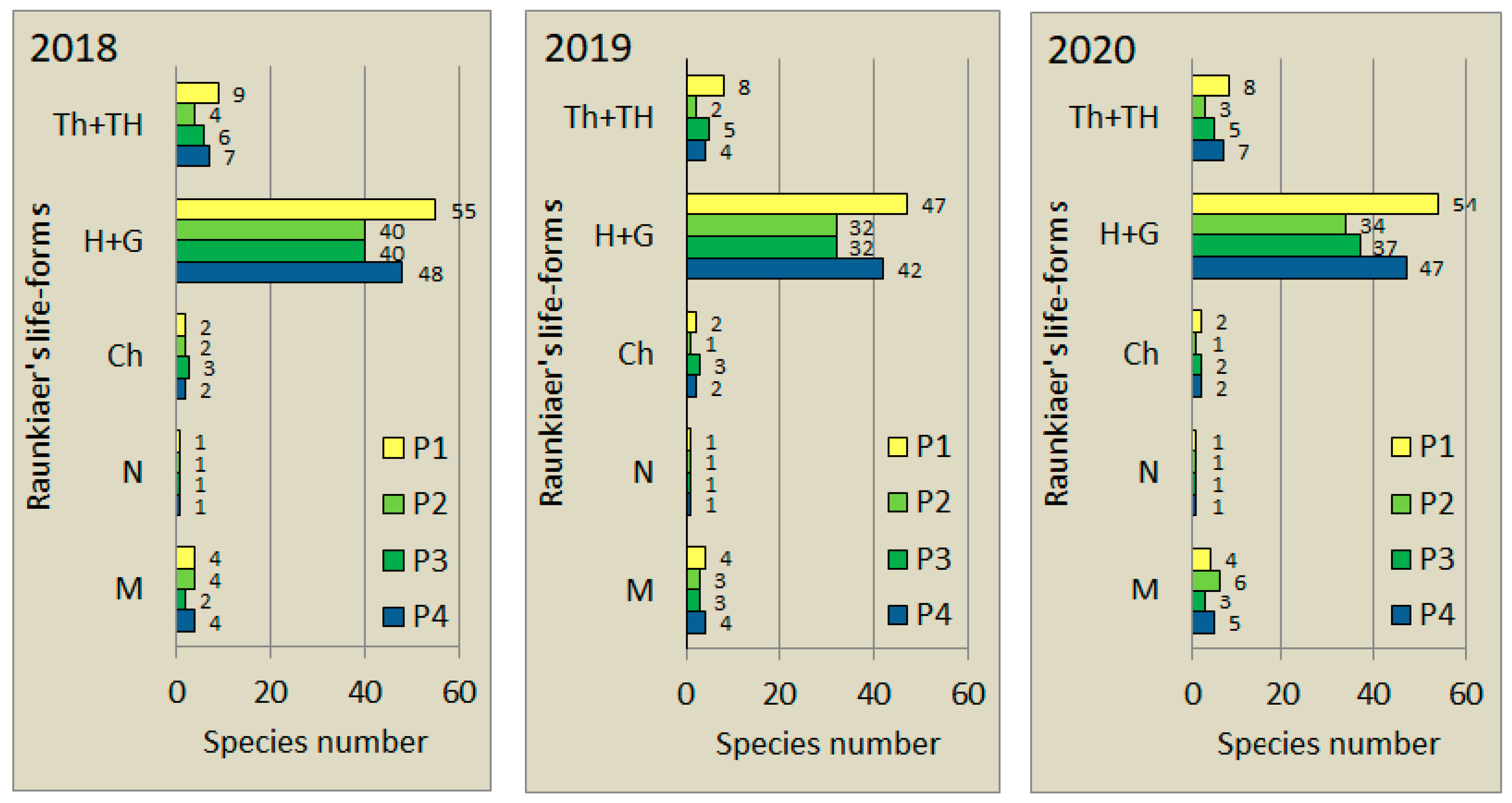
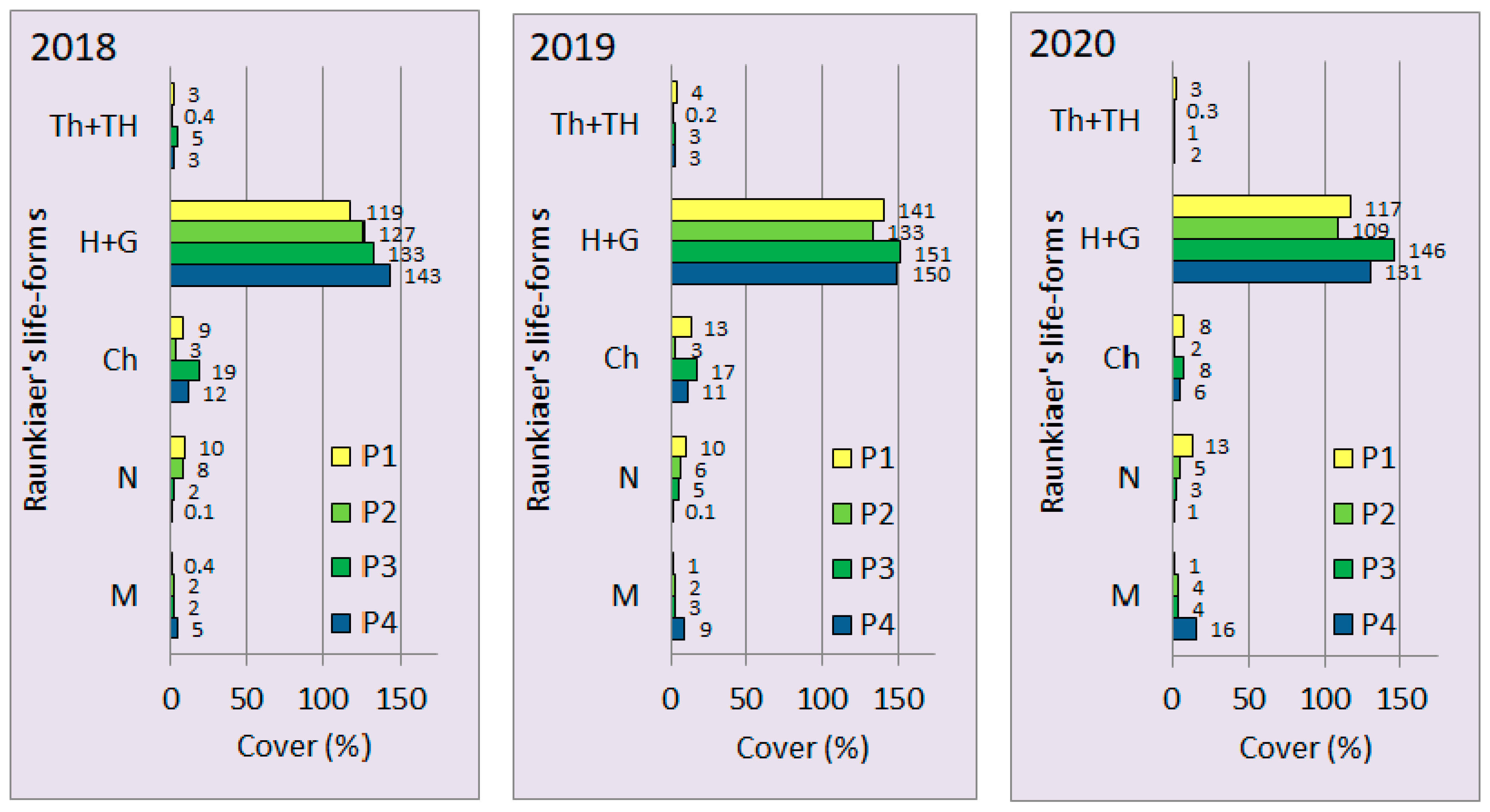
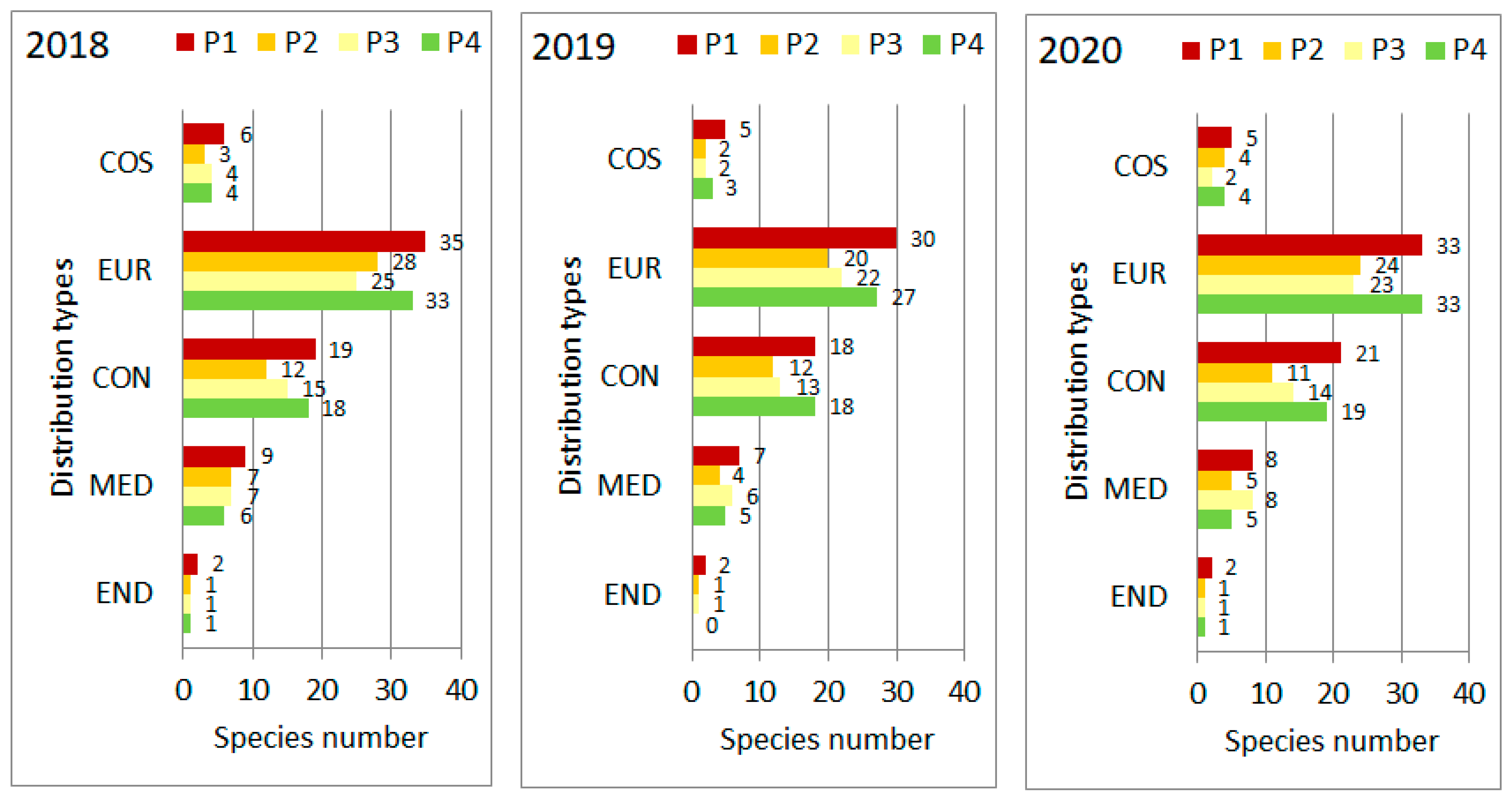
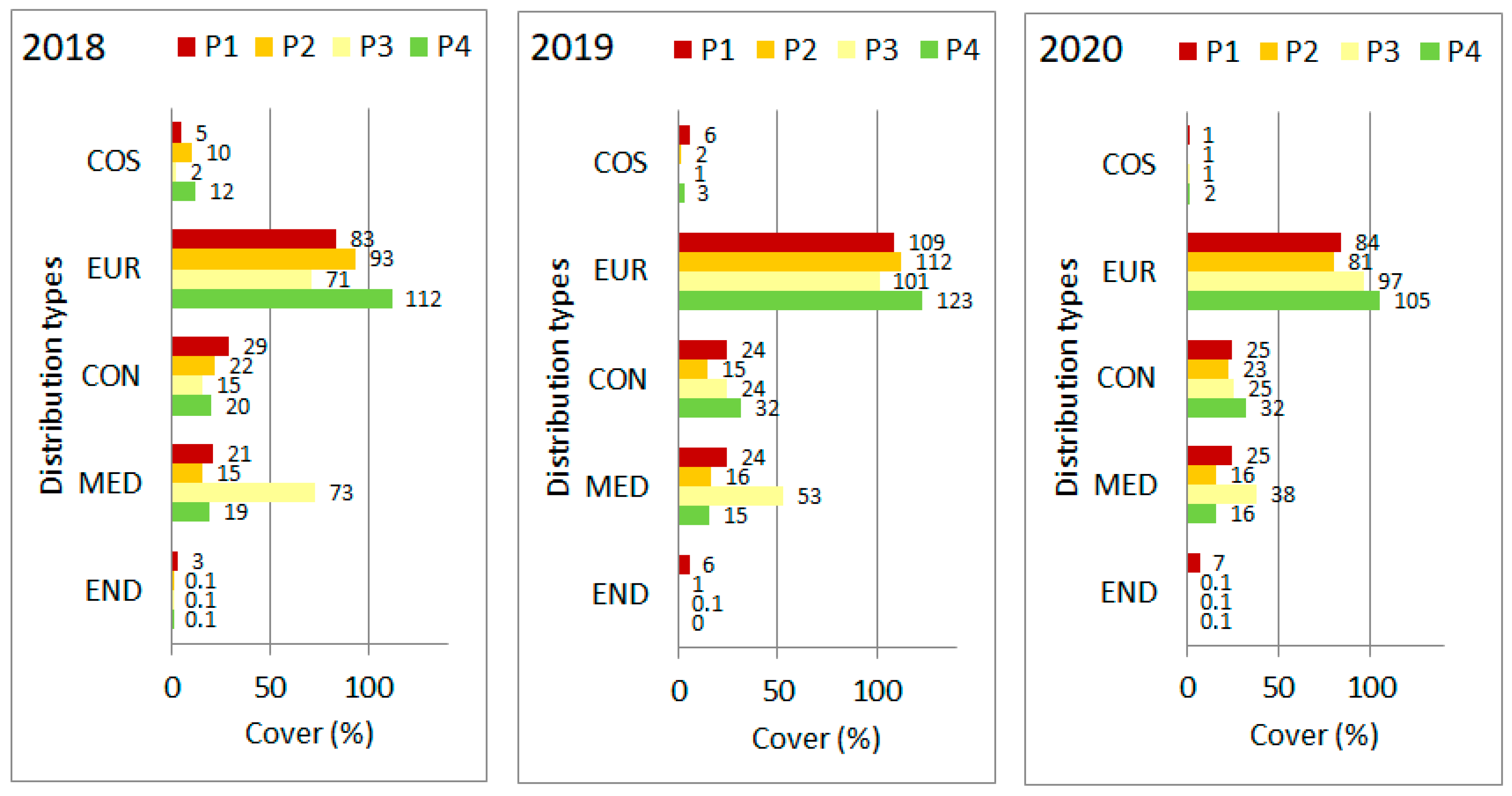
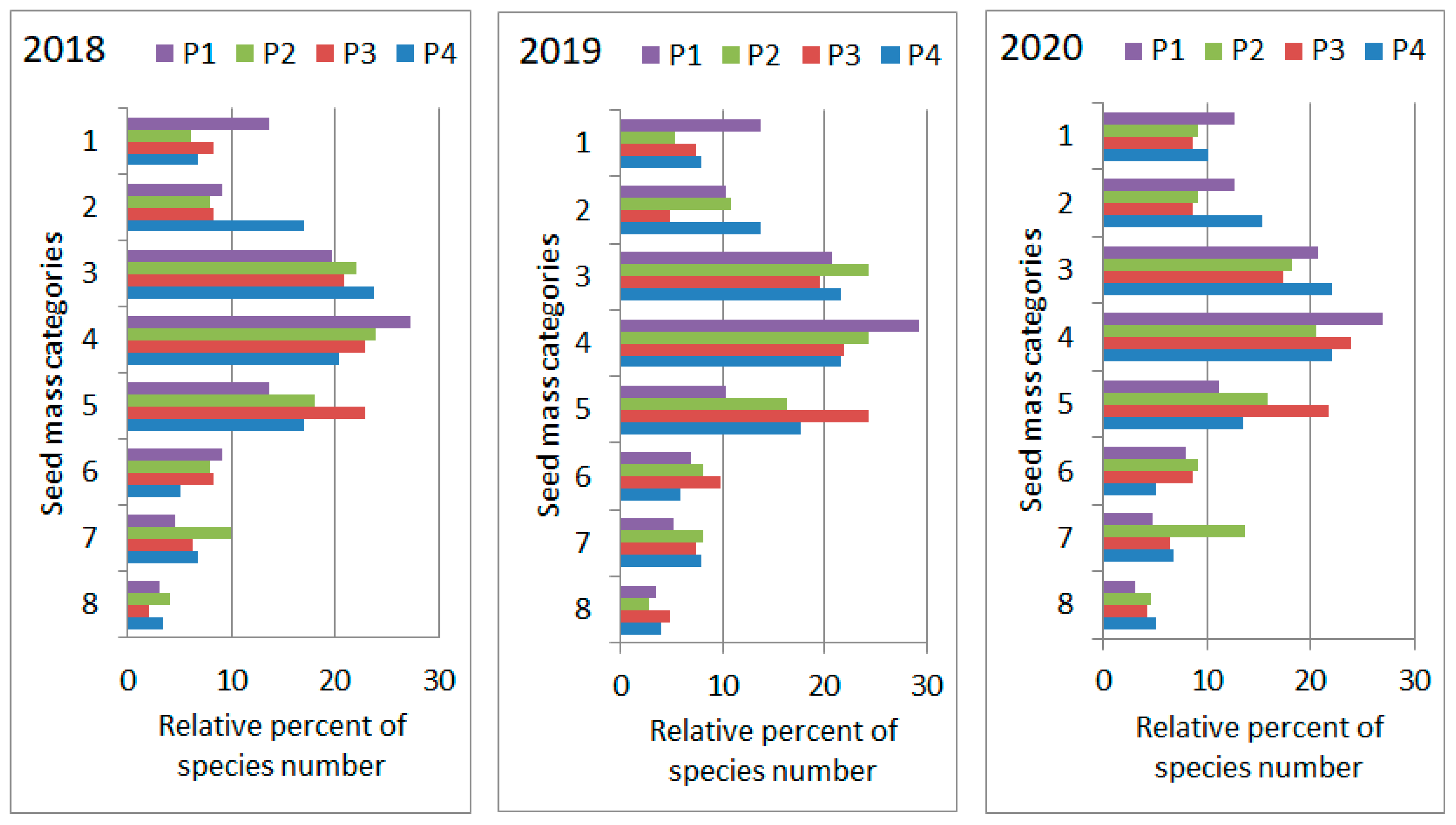
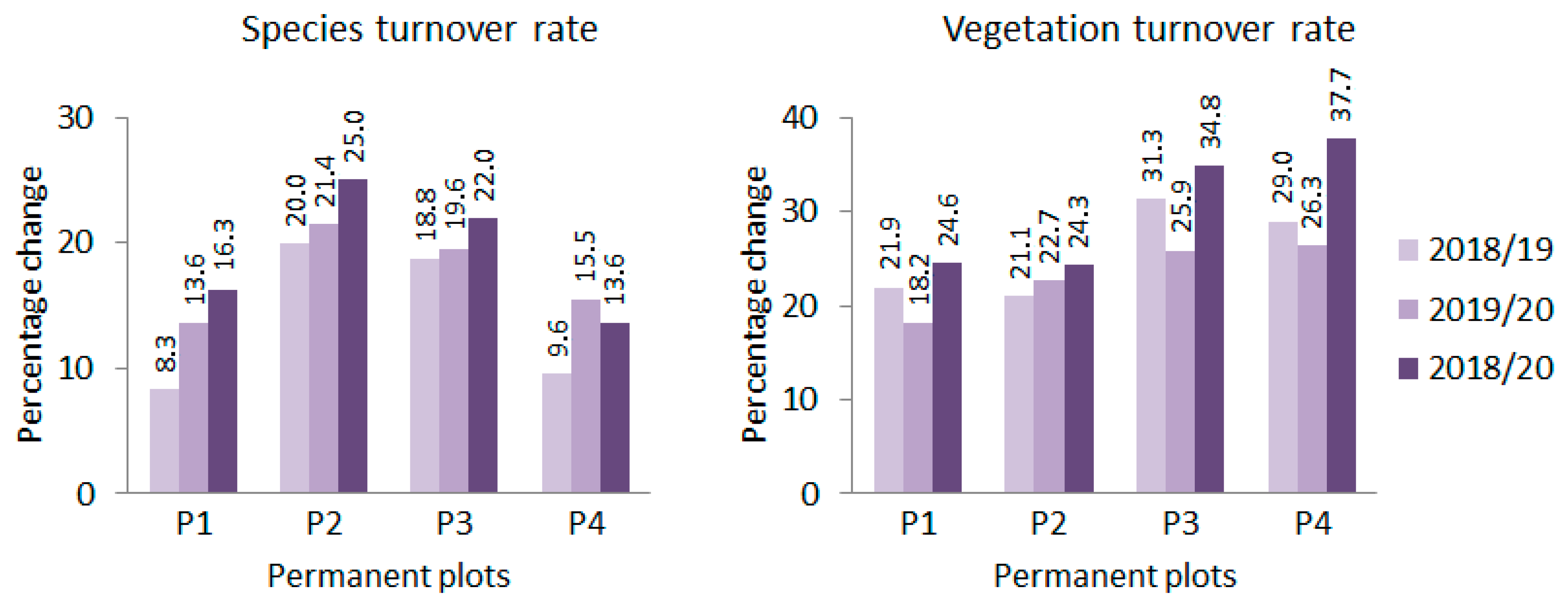
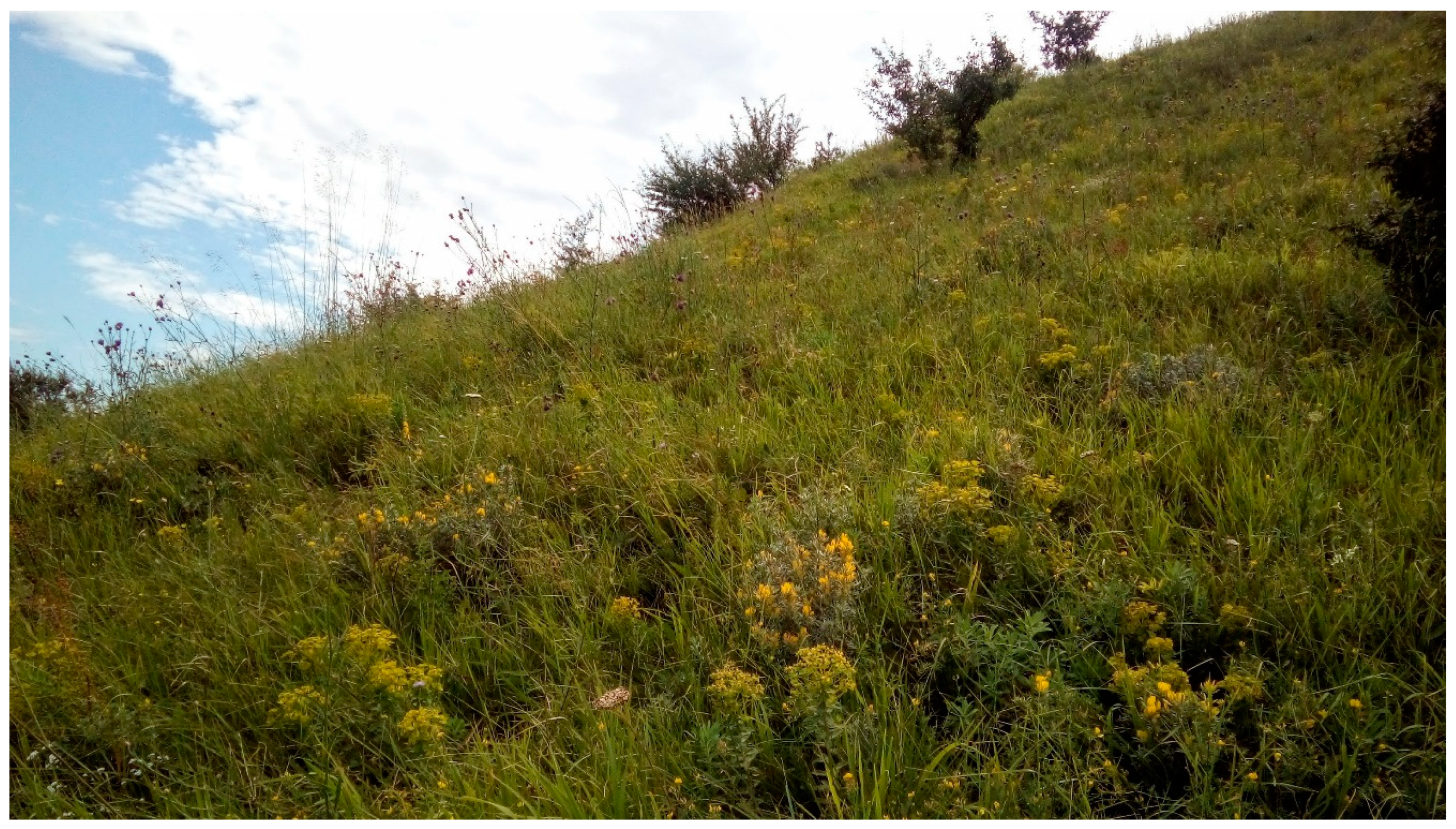
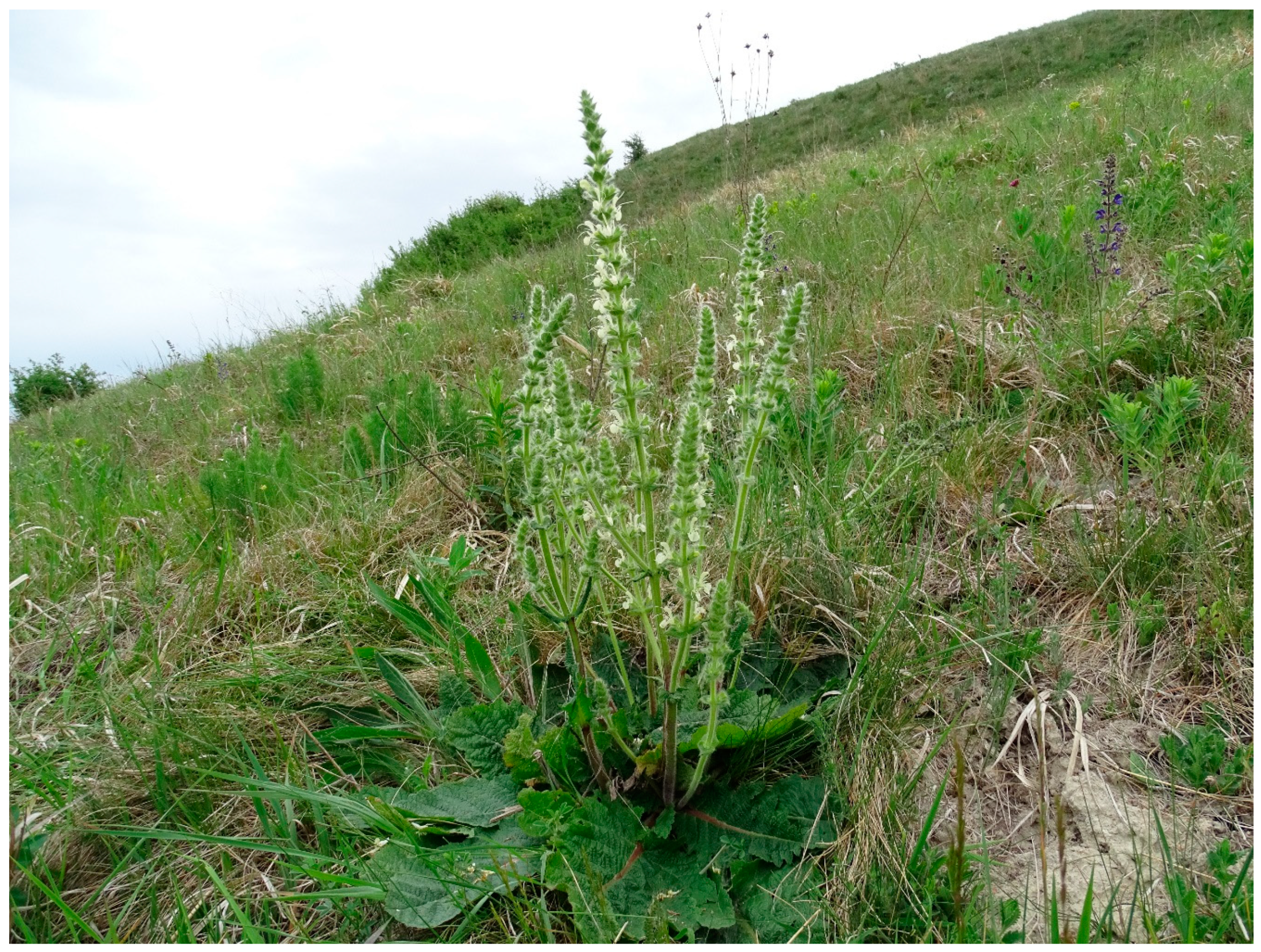
| 2018 | 2019 | 2020 | |
|---|---|---|---|
| P1 | 3.0426 | 2.8841 | 2.7083 |
| P2 | 2.7015 | 2.4605 | 2.6303 |
| P3 | 2.8729 | 2.9251 | 2.8833 |
| P4 | 3.1803 | 2.9649 | 3.0256 |
| Compared Turnover Rates | Rank Sum Difference | p-Value | Significance |
|---|---|---|---|
| species turnover | |||
| 2018/19 vs. 2019/20 | −5.0 | p > 0.05 | ns |
| 2018/19 vs. 2018/20 | −7.0 | p < 0.05 | * |
| 2019/20 vs. 2018/20 | −2.0 | p > 0.05 | ns |
| vegetation turnover | |||
| 2018/19 vs. 2019/20 | +2.0 | p > 0.05 | ns |
| 2018/19 vs. 2018/20 | −5.0 | p > 0.05 | ns |
| 2019/20 vs. 2018/20 | −7.0 | p < 0.05 | * |
Publisher’s Note: MDPI stays neutral with regard to jurisdictional claims in published maps and institutional affiliations. |
© 2022 by the authors. Licensee MDPI, Basel, Switzerland. This article is an open access article distributed under the terms and conditions of the Creative Commons Attribution (CC BY) license (https://creativecommons.org/licenses/by/4.0/).
Share and Cite
Csontos, P.; Tamás, J.; Kovács, Z.; Schellenberger, J.; Penksza, K.; Szili-Kovács, T.; Kalapos, T. Vegetation Dynamics in a Loess Grassland: Plant Traits Indicate Stability Based on Species Presence, but Directional Change When Cover Is Considered. Plants 2022, 11, 763. https://doi.org/10.3390/plants11060763
Csontos P, Tamás J, Kovács Z, Schellenberger J, Penksza K, Szili-Kovács T, Kalapos T. Vegetation Dynamics in a Loess Grassland: Plant Traits Indicate Stability Based on Species Presence, but Directional Change When Cover Is Considered. Plants. 2022; 11(6):763. https://doi.org/10.3390/plants11060763
Chicago/Turabian StyleCsontos, Péter, Júlia Tamás, Zsófia Kovács, Judit Schellenberger, Károly Penksza, Tibor Szili-Kovács, and Tibor Kalapos. 2022. "Vegetation Dynamics in a Loess Grassland: Plant Traits Indicate Stability Based on Species Presence, but Directional Change When Cover Is Considered" Plants 11, no. 6: 763. https://doi.org/10.3390/plants11060763
APA StyleCsontos, P., Tamás, J., Kovács, Z., Schellenberger, J., Penksza, K., Szili-Kovács, T., & Kalapos, T. (2022). Vegetation Dynamics in a Loess Grassland: Plant Traits Indicate Stability Based on Species Presence, but Directional Change When Cover Is Considered. Plants, 11(6), 763. https://doi.org/10.3390/plants11060763







